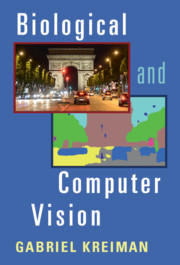Book contents
- Biological and Computer Vision
- Biological and Computer Vision
- Copyright page
- Dedication
- Contents
- Figures
- Preface
- Acknowledgments
- Abbreviations
- 1 Introduction to the World of Vision
- 2 The Travels of a Photon
- 3 The Phenomenology of Seeing
- 4 Creating and Altering Visual Percepts through Lesions and Electrical Stimulation
- 5 Adventures into Terra Incognita
- 6 From the Highest Echelons of Visual Processing to Cognition
- 7 Neurobiologically Plausible Computational Models
- 8 Teaching Computers How to See
- 9 Toward a World with Intelligent Machines That Can Interpret the Visual World
- 10 Visual Consciousness
- Index
- References
8 - Teaching Computers How to See
Published online by Cambridge University Press: 05 February 2021
- Biological and Computer Vision
- Biological and Computer Vision
- Copyright page
- Dedication
- Contents
- Figures
- Preface
- Acknowledgments
- Abbreviations
- 1 Introduction to the World of Vision
- 2 The Travels of a Photon
- 3 The Phenomenology of Seeing
- 4 Creating and Altering Visual Percepts through Lesions and Electrical Stimulation
- 5 Adventures into Terra Incognita
- 6 From the Highest Echelons of Visual Processing to Cognition
- 7 Neurobiologically Plausible Computational Models
- 8 Teaching Computers How to See
- 9 Toward a World with Intelligent Machines That Can Interpret the Visual World
- 10 Visual Consciousness
- Index
- References
Summary
We have come a long way since our initial steps toward defining the basic properties of vision in Chapter 1. We started with characterizing the spatial and temporal statistics of natural images (Chapter 2). We summarized visual behavior – that is, how observers perceive the images around them (Chapter 3). Lesion studies helped define specific circuits in the cortex that are responsible for processing distinct types of visual information (Chapter 4). We explored how neurons in the retina, the thalamus, and the ventral visual cortex respond to a variety of different stimulus conditions (Chapters 2, 5, and 6).
- Type
- Chapter
- Information
- Biological and Computer Vision , pp. 152 - 191Publisher: Cambridge University PressPrint publication year: 2021

